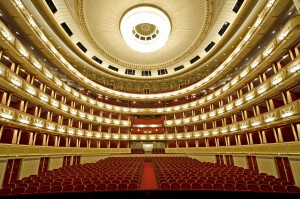Recently, Dominique Meyer, the Director of the Wiener Staatsoper – along with a team from the Opera House – returned to the Austrian Embassy in London to outline the opera house’s artistic plans for the 2015/16 season and to provide an update on the ‘live at home’ technology.
The technology is being used in the field of learning – as opposed to entertainment – via a schools programme. This allows large numbers of young people in Austria and elsewhere to discover the opera house and its many professions; experience live rehearsals, and watch live broadcasts of opera or ballet performances during school hours – thanks to the service’s time-shifted broadcasts.
“Wiener Staatsoper live at home will make the Wiener Staatsoper an international leader in the use and continued development of innovative technologies for the distribution of its performances,” said Dominique Meyer. “No other opera house can offer international audiences a programme of such a scope and of such high quality.”
The ‘live at home’ service will make more than 40 live broadcasts from the opera house available to subscribers, who pay 14 euros for a ‘single live ticket’, 88 euros a month (11 euros per performance) or 320 euros a year.
The service – a collaboration between the opera house and Samsung – began officially in May 2014. As this blog reported at the time, audiences worldwide can watch live, or ‘time zone delayed’, via any television connected to the internet, using a SmartTV with a web browser, or via a computer. The video and audio transmitted is of up to full HD quality, depending on the subscriber’s internet connection.
The Wiener Staatsoper now has eight HD cameras as well as state-of-the-art digital video and digital audio studios. The filming work for the live broadcasts happens without affecting members of the audience or the artists on stage. For the live editing of opera and ballet streams, the Wiener Staatsoper has set up three video teams each consisting of two cameramen, a musical score assistant, a director and assistant director.
In addition to the live stream, the ‘Wiener Staatsoper second screen app’ gives viewers synchronised multilingual subtitles. This app, which can be downloaded, free, from the Google Play Store and the App Store, enables users to receive – on tablets or smartphones, Android or iOS – synchronised subtitles (in English, German, Korean and Japanese). The subtitles’ synchronisation is made possible by a process known as audio watermarking.
There is even a synchronised score available with many performances. In addition, the ‘Wiener Staatsoper Programmheft App’ (programme booklet app) can be downloaded, free, from the Google Play Store and the App Store, to provide a rich multimedia programme booklet in English and German.
“We’re launching our programme on TV’s leading platforms through the internet before Christmas,” said Mr Meyer. “These live broadcasts can be enjoyed – and paid for – on Apple TV, Amazon Fire and Android TV, as well as on all main manufacturers’ SmartTVs. Everybody today has an iTunes or Amazon account, or uses Paypal – so there’s no longer the need to register or clear payment on a website before watching. In addition to these services, we’ll launch apps on big carrier networks, starting with A1 Austrian Telekom in November, UPC Horizon europewide in March 2016 and on TELSTRA for the Asia/Pacific region in April.”
For further details of the Wiener Staatsoper live at home service, visit www.staatsoperlive.com









Leave A Comment
You must be logged in to post a comment.